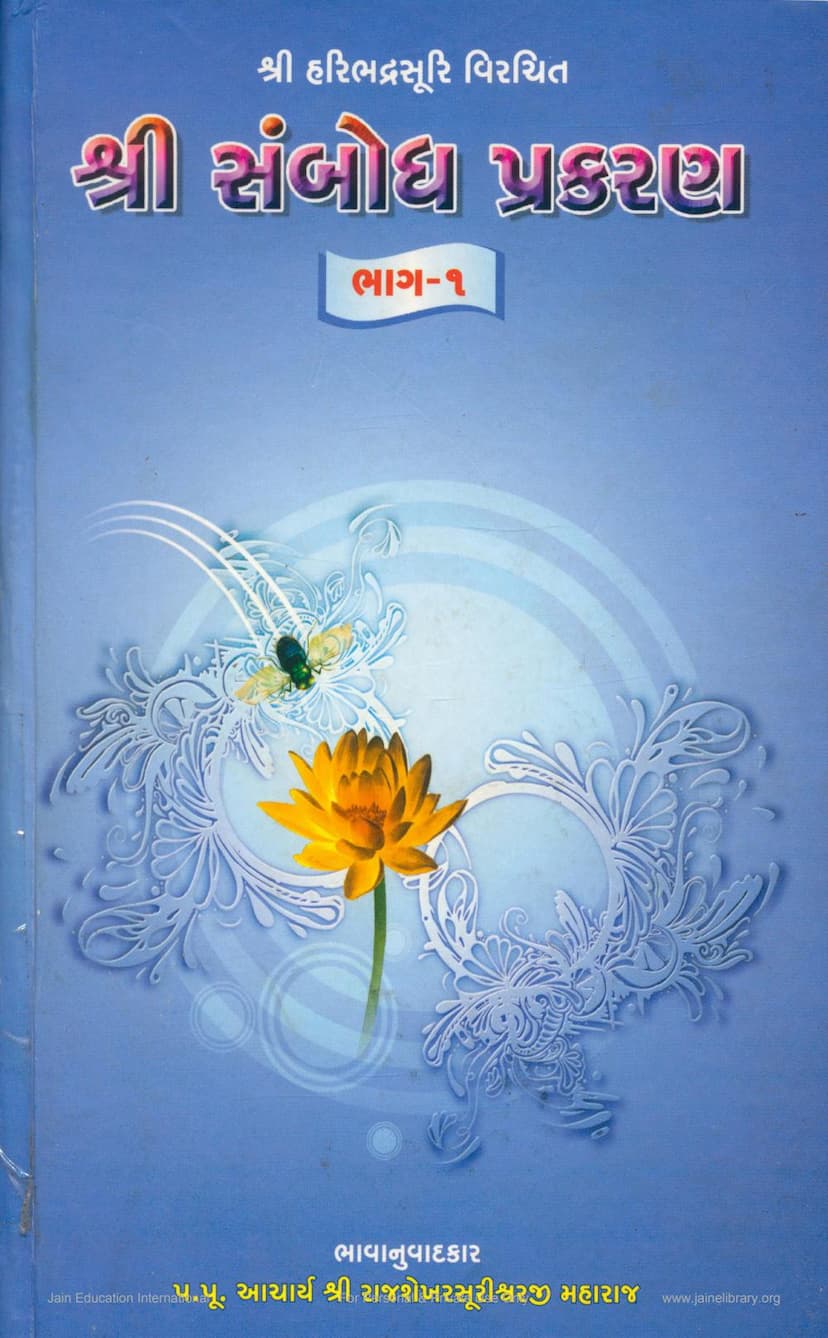Sambodh Prakaran Part 01
Added to library: September 2, 2025

Summary
Here's a comprehensive summary of the provided Jain text, "Sambodh Prakaran Part 01," focusing on its content and introductory material:
Book Title: Sambodh Prakaran Part 01 Author(s): Rajshekharsuri, Dharmshekharvijay (as translator/editor) Publisher: Arihant Aradhak Trust
Overall Purpose:
The text is a Gujarati translation and commentary of the "Sambodh Prakaran" (also referred to as "Sambodh Karani" and "Sambodh Sitar"), originally composed by Acharya Haribhadrasuri Maharaj. The primary goal of this work is to elucidate the path to liberation (Moksha) and provide spiritual guidance to both ascetics (sadhus) and householders (shravaks).
Key Introductory Elements and Themes:
- Invocation and Homage: The book begins with invocations to Lord Shankheshwar Parshvanath, Dharanendra-Padmavati, and the lineage of Gurus, including Shri Dan-Prem-Ramchandra-Hirasuri, and the immediate spiritual lineage leading to Acharya Rajshekharsuri. This highlights the importance of reverence for deities, spiritual preceptors, and the Jain tradition.
- Authorial Intent and Collaboration: Acharya Rajshekharsuri explains his motivation for undertaking this translation, which stemmed from realizing the profound usefulness of the original text for the entire Jain community (Chaturvidh Sangh). He emphasizes the collaborative effort involved in correcting textual inaccuracies and ensuring the purity of the translation, acknowledging the contributions of various Munis and scholars. The phrase "ઝાઝા હાથ રળિયામણા" (Many hands make light work) underscores this cooperative spirit.
- Methodology and Scholarly Approach:
- Textual Accuracy: The translation involved a meticulous process of cross-referencing and consulting multiple handwritten and printed manuscripts to eliminate errors and understand the original meaning.
- Use of Source Texts: A significant list of 350 "Gathas" (verses) from various Jain scriptures and philosophical texts were consulted and utilized as references, demonstrating a deep scholarly engagement with the Jain canon. This extensive reliance on foundational texts ensures the translation aligns with the core principles of Jainism.
- Understanding Metrical Rules: A detailed explanation of the Arya meter (Gatha) is provided, including rules regarding syllable counts, matras (beats), and permissible variations. This demonstrates a commitment to linguistic and poetic accuracy in rendering the text.
- Structure and Content: The "Sambodh Prakaran" is divided into three parts:
- Part 1: Focuses on Dev Adhikar (Deity section) and Guru Adhikar (Guru section, Division 1: Kigurū Adhikar - False Gurus).
- Part 2: Continues with Guru Adhikar (Division 2: Sugurū Adhikar - True Gurus) and includes supplementary material.
- Part 3: Covers various other crucial topics such as Samyakva Adhikar (Right Belief), Avirat Samyagdrushti Adhikar (Non-abstinent Right-believer), Shravak Pratima Adhikar (Lay vows), etc., up to Dhyan Adhikar (Meditation), Mithyatva Adhikar (False Belief), and Alochana Adhikar (Confession).
- Theological and Philosophical Emphasis: The text delves into core Jain principles, including:
- Mangal (Auspiciousness): The importance of starting any endeavor with auspicious rituals and invocations.
- Anubandh Chaturthaya (Fourfold Context): The introduction to any text, including the topic, purpose, and connection.
- Nature of Devotion: The text emphasizes that true devotion (Bhav Puja) is paramount, and even external rituals (Dravya Puja) are valuable if performed with the right intention. It clarifies the distinctions between different types of deities and the importance of worshipping the Tirthankaras.
- Concept of Karma and Liberation: The underlying theme is the path to liberation from the cycle of birth and death (samsara) through virtuous conduct, right belief, right knowledge, and right conduct.
- Importance of Gurus: The text highlights the critical role of true Gurus (Sugurū) in guiding individuals toward liberation and warns against false Gurus (Kigurū).
- Conduct and Ethics: It elaborates on various aspects of Jain conduct, including the meticulous avoidance of even minor harm to living beings (Ahimsa), the significance of rituals like Pujā (worship), and the observance of ethical principles (Āshātanā - transgressions to be avoided).
- Nirakara and Sakara Worship: The text distinguishes between worshipping the formless essence of the liberated soul (Nirakara) and worshipping the manifested form of the Tirthankaras (Sakara), emphasizing the latter as a means to spiritual progress.
- The Three "Karan" (Stages of Spiritual Progress): Yathapravrattikaran, Apurvakaran, and Anivrittikaran are explained as crucial stages in the soul's journey towards liberation.
Key Chapters/Sections Covered in Part 1:
- Dev Adhikar (Deity Section): This section likely focuses on the attributes and worship of the Tirthankaras and other celestial beings (Devas) who are considered worthy of veneration in Jainism. It details the characteristics of true deities and the proper methods of worship.
- Guru Adhikar (Guru Section): This section begins by defining the different types of Gurus, emphasizing the characteristics of a true Guru (Sugurū) and the dangers posed by false Gurus (Kigurū). It likely outlines the qualities to look for in a spiritual guide and the pitfalls of associating with unqualified individuals.
In Essence:
"Sambodh Prakaran Part 01" serves as a foundational text in Gujarati, providing a detailed and scholarly exploration of Jain devotional practices, the nature of veneration, the importance of virtuous conduct, and the spiritual guidance offered by the Tirthankaras and the monastic lineage. It is a comprehensive guide to understanding and practicing the Jain path to spiritual upliftment and ultimate liberation.